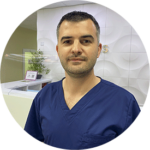Embryo monitoring (e.g., time-lapse system, EmbryoScope). Can it boost IVF success rates?
Does embryo monitoring boost IVF success? What is it, and how it works?
What is embryo monitoring, and what role does it play during IVF treatment? What are the advantages of using real-time monitoring? Does it affect embryo quality or their selection?

Timelapse technology, so historically what happened was: you would have your egg collection, they would go into incubator, we’d mix take them out of the incubator, mix the sperm, we’d check them the next morning, they’d go back in the incubator, you might check them on day two, you might check them on Day 3, you might check them on Day 5 and again on Day 6. So all you get is little snapshots and you’re having to remove them from their environment to check them bearing in mind embryos have to be cultured in high co2 environments – not 20% oxygen which is what the normal atmospheric conditions are. So you’re disrupting their environment by doing that. With time lapse apps what it allowed to do was to basically put a camera into the incubator and you can monitor all of those embryos every 10 minutes without disturbing that environment and what that allowed us also to do is see the whole development throughout their entire process and that allowed us to deselect embryos so, for an example, if you on the old system if you checked an embryo and it was fertilized and then a two cell and then an eight cell and then the blastocyst didn’t think it was good. With the time lapse you might see the fertilization, then that divide straight into three cells and then (which is not a good development point) you might see it not be as good on Day 3 and then but it still makes a good quality blastocyst and it’s allowing you to deselect those embryos and look at the what’s called morpho kinetics to help us select the best embryos for patients and give the highest chance of pregnancy. Now, when you compare the outcomes so if you look at clinical pregnancy rate per transfer, whether it’s a time-lapse embryo or a conventional incubator embryo, the pregnancy rates are identical but what the laboratory key performance indicators have shown actually in the time-lapse incubator, you get a lot more blastocystis formed significantly amount improved blastocyst formation rate and what that does is allows us to freeze more blastocysts. So say you get four blastocysts frozen in a time lapse and three in a conventional incubator, you’ve then got up to four attempts of frozen embryo transfers of getting pregnant versus three with a conventional so you have a higher cumulative life birth rate using time lapse technology.

Okay, so with time-lapse we improve them in the laboratory because we avoid taking embryos to see the great old days. So, there are studies showing that the quality of the embryos and their score improves with a time-lapse and there are studies that say there is no difference between the time-lapse or commensal. But it’s helpful for the embryologist to see all the diameters, and you can see all the division and the nucleation as well, so yeah, it’s very helpful.

Embryo monitoring or time-lapse monitoring, or EmbryoScope, Primo Vision are the types, we think this is a very good and a very modern method. The principle is that there is hardware with micro cameras above each embryo that are taking pictures every couple of minutes according to the system, and the software turns it into animation so the embryologist can closely follow the embryo’s development for a full 24, 48, or up to 120 hours. And so they see which embryo has the best quality of development, which embryo could be the best for embryo transfer, embryo freezing, or PGD testing.

Embryoscope is an incubator pretty much like the incubators that we have in the lab that we grow the embryos in. It is a closed system that allows the culture of embryos without us interrupting them that because it had very advanced technology that takes a photo of the embryo every few seconds and you have a view of the embryo as video on the screen and you can assess the embryo without removing it from the incubator. The advantage of the embryoscope is that it is using advanced software and algorithms that helps us in the lab to select the best embryo for transfer and freezing. Again, the best embryo that has the highest success for the pregnancy based on the algorithm that the embryoscope has.

Time-lapse is a photographic technique used in cinematography to show different events that happen at very slow and imperceptible speed to the human eye. Several still images are captured at certain intervals of time. They are subsequently joined and assigned specific speed so that everything that has been captured moves quickly, achieving the visual effect – namely, the time-lapse effect.
This technology has been incorporated into assisted reproduction laboratories as a system that allows constant observation of the development of embryos cultured in vitro. It does so by capturing images at certain intervals of time, without having to remove the embryos from their cultural environment. In this way, the conditions remain stable, thus, favouring the embryo development. Also, much more information is obtained from embryos. That makes us analyse them, compare them and select them better than in a conventional way by being able to see in full camera all the in vitro development. So we can have a better selection and choose the best embryo to transfer.
Besides, the time-lapse software allows creating reports and videos for each of the embryos. With it, we have a very useful tool to help us explain to patients why some of their embryos have been selected to be transferred and frozen, while others not.
This device allows controlling the evaluation of embryos. It facilitates embryo development under stable conditions and without the influence of external human and environmental factors. Contrary to what happens in conventional incubators, which require continuous human manipulation to evaluate and select the best embryos. This computer technology allows greater precision than the human eye.
Time-lapse technology also allows increasing pregnancy rates by up to 20%, compared to traditional incubators used in assisted reproduction.

The morphological method is the main indicator of how we evaluate embryo quality. Embryos are evaluated according to the following criteria: number of blastomeres, quality of blastomeres, and the presence of fragmentation. However, this is an old method of assessing the quality of embryos, it is not without drawbacks, and it is subjective. The embryo is extremely variable in its development. Ugly duckling embryo quality on the second day can develop into a completely healthy and very pretty baby.
Currently, a new game changer – the EmbryoScope method – turned up for assessing the quality of embryos. Its principle is the following: every 10-20 minutes, a snapshot of the embryo is made in 7 layers using a computer program. The pictures are superimposed, one on top of the other, and a short video summary of each embryo is obtained. EmbryoScope is the household name of the device of the new generation. At its core, it’s an incubator that supports the conditions for the growth and development of cultured embryos. But there is a difference that makes the breakthrough in reproductive biology. Using the lenses and the camera built into EmbryoScope, we can observe what change occurred in vitro with embryos from the moment of fertilization and up to 5-6 days of the development. The camera takes pictures every few minutes. The images subsequently form a video in which we see how the embryo was at what time, in what sequence it grows, and the fragmentation of the cells of the embryo progress.
Recently a large study was conducted and the result showed the analysis of those embryos that gave pregnancy and subsequent births. It turned out that all those embryos had similar crushing time intervals and other time-related morphological criteria. The so-called time-lapse system showed that a new direction of morphology was born: morphokinetics. Using retrospective analysis, morphokinetics gives us answers to many questions that were previously a mystery.
This new technology can significantly increase the chances of pregnancy. On one hand, it is no longer necessary to get the embryo out of the incubator every day to study it under a microscope.
Now, the embryo is not affected by physical factors, which it is most sensitive to at this stage of its development: temperature changes, light, vibrations, or sound. On the other hand, we can select the best embryos with the highest potential of implantation and pregnancy. EmbryoScope allows us to see in real-time what we previously could only guess about. Now we can replace assumptions, such as what really happened to the embryo from the moment we saw it for the last time, with full science confidence. It is also important that future parents can subsequently see how the life of their unborn child progressed from minute to minute.
The use of EmbryScope will allow even wider access to the selective transfer of one embryo. A selective transfer of one embryo allows us to reduce the number of multiple pregnancies without reducing the overall pregnancy rate. It significantly minimizes the risk of complications for both the mother and her unborn child. Preimplantation genetic screening (PGS) makes it possible to select euploid embryos with a high probability of implantation. It allows to increase the effectiveness of IVF programs, reduces the frequency of early reproductive losses, and increases the frequency of gestation.

It’s a very difficult question. We have different types of time-lapse systems: EmbryoScope, Esco system, Primo Vision, and a few others. They are all based on the method of pictures taken every few minutes without disturbing the conditions in which embryos are kept. Time-lapse is a very helpful tool in the hands of embryologists. Before the era of the time-lapse system, we had only the possibility of morphological assessment. For example, the assessment of the cleavage stage is based on two main criteria: the number of cells and their morphology. The blastocyst scoring is also based on two different criteria: the expansion state of the blastocyst and the consistency of the inner cell mass and trophectoderm cells. Time-lapse gives us more information. Morphokinetics, as seen with time-lapse, can enhance the power of embryo selection because it allows for morphology to be assessed more accurately.
Time-lapse embryo monitoring allows continuous and – what’s very important – non-invasive embryo observation, without the need to remove the embryo from the incubator and the optimal culture conditions. The extra information about the cleavage pattern, morphological changes, and embryo development dynamics could help us identify the embryo with the higher potential. This assessment is very closely related to the optimal time of the individual embryonic division.
In my opinion, time-lapse is particularly important in two situations. Firstly, it’s when we perform the transfer on the second or the third day. At this stage of embryo development, morphokinetics is very important. Embryos that are observed up to the blastocyst stage undergo a kind of natural selection. Some of them, especially the ones with big defects, stop developing. Secondly, it’s the situation when we have more embryos than we can transfer. Two blastocysts, looking the same, do not always have the same potential. When we compare two equally looking blastocysts, we can sometimes see small and sometimes large gaps in embryo development.
Unfortunately, sometimes things that seem obvious and beneficial to us have no confirmation in clinical trials. Basing on the Cochrane Library, several clinical trials say there is no clear evidence that the time-lapse system increases pregnancy or live-birth rates. This means that, although a time-lapse system is a very helpful device, it will not replace a good embryologist.

Let’s talk about embryo monitoring. Well, that, I think, is one of the new additions to fertility treatments in the last few years, and I personally love it. In the old times, the way to select the embryos to be transferred was based purely on the embryo morphology. So the biologist would check the embryo on day one, then on day two and day three, and the assessment would be by the number of cells, the shape of these cells and the fragmentation of these cells. And it was a morphological assessment, just based on the shape of the cells and the embryo in total.
Nowadays, there are these new technologies, embryo lab technologies, where you have to imagine an incubator with a camera on top of the embryos. That means that we can observe the embryos all the time without having to open the lead or do anything invasive to the embryo. So we can leave the embryos secluded in their incubator, not touching them and letting them grow naturally. So that’s one of the main advantages that the embryos grow better because we are not interfering with anything. The second advantage is that this camera can take pictures of the embryos, for example, every 20 minutes on different planes. And that creates a video of the embryo where you can see its evolution. So that means that next to the morphology, you can see how it grows, what is the growth rate, what is the morphokinetics of the embryo and that gives you also a prognosis of the vitality of these embryos. It is very nice information to have because you can select the best embryo to transfer.
So first, you are helping the embryos to grow better. Second, we are choosing the best embryo to transfer because we have more information when we see how they grow. So both things increase the success rate of this embryo transfer. Some studies suggest up to 20%. It depends, but this is worth to apply this technique. The third advantage is that at Institut Marquès, for example, we have the so-called Embryomobile. That means that we can send the patient a link, and they can see the embryos on their mobile. It is as if they were in the lab with the biologists checking the embryos at the same time. They can see when we are telling them the information about the embryos, they have the video of the embryos in front of them. They see that what we have seen is what is there. It is a piece of open information, as when you’re in a restaurant, and you can go into the kitchen and see how they do the process, so that would be the same. And I think that’s very nice because the patients feel that the information given is open, and they can follow the process from the beginning, they are checking their embryos and, psychologically, this also has an impact on the patient that, who knows, it may also affect the chances of implantation. Some studies suggest that this might be the case, so embryo monitoring is one of the new resources that increases the success rate in fertility treatments, and I recommend everybody to go for that.
Related questions
Are there any legal restrictions with spindle technique?

What is the success rate with mitochondrial transfer?










